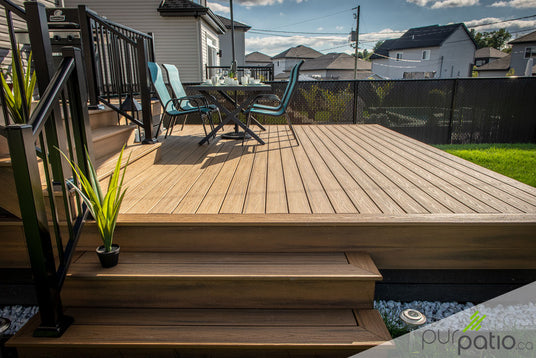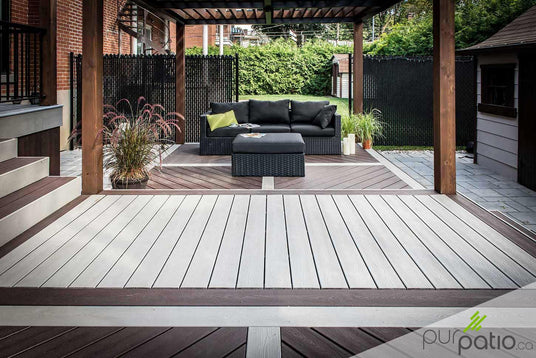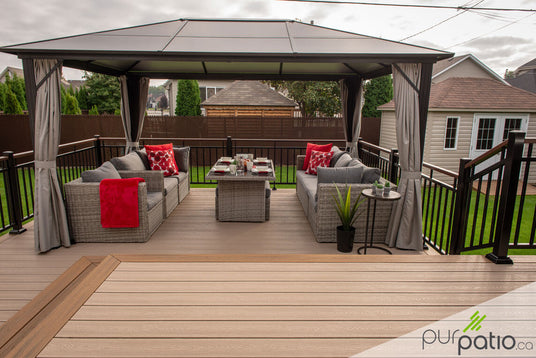
Patio avec pergola intime Laval
Design personnalisé d'un patio en composite TimberTech avec une pergola en cèdre qui intègre un mur d'intimité ainsi que des découpes en acier galvanisé.
Bienvenue sur notre boutique
Tout d’abord, le premier facteur à prendre en considération pour diminuer la chaleur du composite est la marque choisie. Plusieurs compagnies offrent des produits intéressants, mais pas toujours de bonne qualité. Dans les magasins à grandes surfaces, vous allez souvent retrouver un composite ou un PVC en spécial à un prix vraiment alléchant. La mauvaise surprise, c’est qu’il s’agit probablement d’un produit fabriqué en Chine, avec une coquille de mauvaise qualité et si tel est le cas, il absorbera beaucoup plus la chaleur. On dénote également des problèmes de porosité qui accentue la décoloration et garde les taches ainsi que des problèmes d’expansion. Les produits conçus et fabriqués en Amérique sont des composites et des PVC de qualité, adaptés à nos conditions. Certes, ils sont plus dispendieux, mais leur fabrication et leur garantie sont de loin supérieures. Les durées de la garantie varient entre 25 et 50ans dépendant de la marque et de la gamme choisie! Si vous voulez être certain de ne pas vous tromper, fiez-vous aux marques connues qui ont fait leurs preuves chez nous.
Photo: Patio en composite d’une marque connue fabriquée en Amérique du Nord.
Le deuxième élément important, c’est la couleur. Tout comme pour le bois, plus la couleur du composite est foncée, plus elle absorbera de chaleur lors d’une journée ensoleillée. Au contraire, plus la couleur choisie est pâle, moins la surface deviendra chaude. Une stratégie intelligente, qui maximise à la fois le look et le côté pratique de votre terrasse, consiste à créer un duo de couleurs. Vous choisissez une couleur pâle pour le centre de votre plancher et une plus foncée au pourtour. Vous bénéficierez ainsi d’une surface qui absorbera moins la chaleur tout en rehaussant le style de votre patio! La chaleur du composite versus du bois non-teint est sans contredit supérieure. Cependant, la majorité des gens qui construisent un patio en bois vont le teindre. Si l’on compare un patio en bois traité et en composite d’une couleur similaire, le résultat varie en moyenne de seulement 5 degrés Celsius.
Photo: Exemple d’un patio en composite avec centre plus pâle et accents au pourtour foncés. Ceci permet de limiter la chaleur sur la majorité de la superficie.
Pour résumer, oui le composite est un peu plus chaud que le bois d’une même couleur. Mais quels sont les autres éléments à prendre en considération lorsqu’on doit faire un choix? Le composite possède plein de qualités que le bois ne peut égaler. De plus, combien de journées dans l’été seront véritablement très chaudes et pleinement ensoleillées? Pas beaucoup. La chaleur du composite peut aussi être diminuée en aménageant des éléments d’ombrage sur son patio. Que ce soit un simple parasol, une pergola avec végétation ou voile d’ombrage ou encore un gazebo, ces éléments contribuent à protéger le composite du soleil, réduisant ainsi la chaleur qu’il absorbe. L’important, c’est de bien identifier ses besoins et de peser le pour et le contre avant de faire un choix afin de ne pas le regretter.
Pour vous aider à faire un choix de matériaux, inspirez-vous de nos réalisations!
Photo: Patio avec gazebo pour offrir une zone ombragée où le composite absorbera moins la chaleur.


